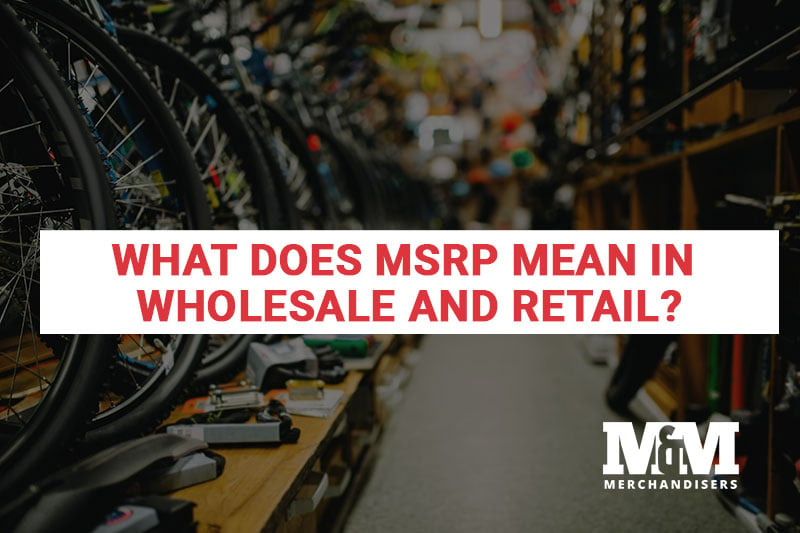What Does MSRP Mean In Wholesale and Retail?

You want to please your customers by providing quality, fast moving products, while still receiving the maximum return on your investment. Whether you own an e-commerce or physical store front, what is the key which will unlock optimum profitability margin? Strategic pricing. By using the Manufacturers Suggested Retail Price (MSRP) to price your inventory effectively, you can entice customers and see a decent profit.
Want to set the best prices possible for your store?
Become a Dealer with M&M Merchandisers to buy goods for your store at wholesale prices!
What Does MSRP Stand For?
Often, you see sticker prices on the products you may buy or sell that is different from the actual price the customer pays. In the retail or wholesale industry, the MSRP is known by many names. They include the following:
- List Price
- Sticker Price
- Recommended Retail Price
- Suggested Retail Price
The MSRP is the main price the manufacturer wishes retailers to honor.
What Does MSRP Price Mean?
MSRP is simply a recommended tool that retailers can utilize to set the prices on their products. The practice is supposed to ensure the fair trading of goods. The MSRP is usually 2.5 to 3 times higher than a recognized wholesale price. With this guideline, some retailers set their pricing either at or somewhat below the MSRP.
Retailers are typically not bound to charge customers the MSRP. They can advertise prices either above, at or below the MSRP to encourage customers to buy their products.
Why Do Manufacturers Suggest Retail Price?
To achieve maximum profitability, manufacturers suggest a retail price so they might realize a profit. They are producers of commodities and like any other business, they have overhead costs to be absorbed, materials ordered, labor hired, taxes paid. A sticker price is what the manufacturer requests to cover these costs and still make a profit.
Related: Why Do Vendors Encourage Retailers to Sell at MSRP?
Why Do Wholesalers Display MSRP?
The prices for wholesale goods are perceived as better bargains than standard retail prices. So why would wholesalers display MSRP? It is a psychological pricing strategy encouraging customers to comparison shop. For example, if you have a name brand washer with a visible MSRP of $650 and you see an advertised price of $475, which would you mentally say is the better deal? Obviously, it will be the lower price.
While buying the lower price option is great for customers, it may not be a viable or even legal option if you become a wholesale partner with a vendor. If a vendor has a standardized MSRP across all it’s venues, it would perceive its brand as being devalued if you advertise a lesser price. One way e-commerce merchants can get around this caveat is to advertise MSRP but then have the customer put the item in the cart. When they click on the cart, it would reveal the actual lower price.
How Can Retailers Use MSRP?
When you understand the MSRP and the reasoning why manufacturers have set their pricing, you can then use it to your advantage to make your store more profitable. How? You use the MSRP as a tool to develop targeted and strategic prices in order to attract a strong customer base.
MSRP should establish competitive prices. Since customers have a huge variety of products from which to choose, they will almost always do comparison shopping. In order to be the one customers keep coming back to, retailers should think about the following competitive pricing strategies:
- Pricing Above or Below the Competition: If you can buy your product at a low price, you can set your price somewhat lower than the MSRP and that of your competitors while maintaining a healthy profit margin.
- Prestige Pricing: Sometimes you are justified in marking up the price of a higher-end item more than is recommended by the MSRP. If it’s in high demand by your customers, yet supply is scarce, then raise your price above the MSRP.
- Psyching Out Customers: Psychological pricing involves using a price that ends with an odd number. With this strategy, customers feel the price to be fair or a bargain. An example of this might be pricing an item ending with an odd number, usually 5, 7 or 9. If an item is $9.95, it is thought the customer might mentally round down to $9.00 instead of $10.00.
- Doling Out the Discounts: Offering discounts below the MSRP is a way to attract customers. Whether you use coupons, Groupon, rebates or any other promotional markdowns, these are sure to be a way to bring in customers who may be tempted to purchase high-end products.
- Multiples: One very popular pricing strategy is to offer a discount for product consumables such as BOGO or 3-for-1 deals. Such multiple buying suggestions often prompts customers to buy a bulk number of discounted items.
- Loss Leader: Sometimes retailers place a mark-down on a product so much below the MSRP, that they do not make a profit. This is referred to as a loss leader. You might consider it as a sort of customer ‘bait’. The extremely discounted price is the bait, with the hope that customer traffic may increase and ultimately buy products with higher profit margins.
Profitability is ultimately determined by the price you place on your products. That in turn is determined by not only product supply and demand, but how you use the MSRP. It is a tool to gain customers and maximize your return on investment. Be flexible in how you use it for each product at different times to maximize the effectiveness of your pricing strategy.
Posted by Lois Haycock
Lois Haycock is a 20+ year retail and eCommerce veteran specializing in project management and business analysis of customer-facing systems and software. Lois is SVP of Digital Transformation at M&M Merchandisers. She also operates several eCommerce stores as well as an executive coaching business. Lois can be reached at lois.haycock@mmwholesale.com



